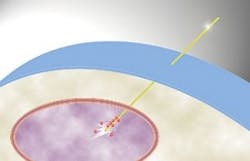Researchers develop nanoneedle to deliver quantum dots to cell nucleus
University of Illinois researchers have developed a nanoneedle to deliver a shot of quantum dots—nanoparticles that can be used to monitor microscopic processes and cellular conditions—to a cell’s nucleus. Quantum dots offer the advantages of small size, bright fluorescence for easy tracking and excellent stability in light.
“Lots of people rely on quantum dots to monitor biological processes and gain information about the cellular environment. But getting quantum dots into a cell for advanced applications is a problem,” said professor Min-Feng Yu, a professor of mechanical science and engineering.
Getting any type of molecule into the nucleus is even trickier because it’s surrounded by an additional membrane that prevents most molecules in the cell from entering.
Yu worked with fellow mechanical science and engineering professor Ning Wang and post-doctoral researcher Kyungsuk Yum to develop a nanoneedle that also served as an electrode that could deliver quantum dots directly into the nucleus of a cell—specifically to a pinpointed location within the nucleus. The researchers can then learn a lot about the physical conditions inside the nucleus by monitoring the quantum dots with a standard fluorescent microscope.
The group coated a single, 50 nm wide nanotube with a very thin layer of gold, creating a nanoscale electrode probe. They then loaded the needle with quantum dots. A small electrical charge releases the quantum dots from the needle. This provides a level of control not achievable by other molecular delivery methods, which involve gradual diffusion throughout the cell and into the nucleus.
“Now we can use electrical potential to control the release of the molecules attached on the probe,” Yu said. “We can insert the nanoneedle in a specific location and wait for a specific point in a biologic process, and then release the quantum dots. Previous techniques cannot do that.”
Because the needle is so small, it can pierce a cell with minimal disruption, while other injection techniques can be very damaging to a cell. Researchers also can use this technique to accurately deliver the quantum dots to a very specific target to study activity in certain regions of the nucleus, or potentially other cellular organelles.
The new technique opens up new avenues for study. The team hopes to continue to refine the nanoneedle, both as an electrode and as a molecular delivery system.
They hope to explore using the needle to deliver other types of molecules as well—DNA fragments, proteins, enzymes and others—that could be used to study a myriad of cellular processes.
The team’s findings will appear in the Oct. 4 edition of the journal Small. The National Institutes of Health and the National Science Foundation supported this work.
Source: University of Illinois
Posted by Lee Mather
Subscribe now to BioOptics World magazine; it's free!

